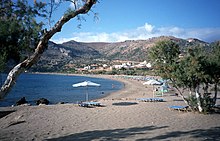Paleochora


Paleochora ( Greek Παλαιόχωρα ( f. Sg. )) Is a town in the extreme southwest of Crete with almost 3000 permanent residents. The short name "Pale" has established itself among regular tourists. The city center is located on a narrow strip of land that is peninsula-like in front of the rapidly rising south coast. Because of this geographical location, Paleochora is at the sunniest point on the island of Crete. The harbor is at the southern end of the headland, and there is another landing stage on the eastern shore promenade. The latter jetty was enlarged in 2018. This is where the ferries and ships dock, the locals and tourists to Gavdos , Sougia or Agia Roumeli (also the exit of the legendary Samaria Gorge), or to the beach of Elafonisi . The distance to Chania is about 72 km. The name means in German "old (main) place"; this implies that the village was uninhabited for a long time or that its function as the central location for the area was temporarily transferred to another place.
Paleochora belongs to the municipality of Pelekanos in the municipality of Kandanos-Selino and, according to various sources, has existed since around 1400 AD. Above the village, the remains of a Venetian fort can be found on a small hill . The excavation of the fort, which has started but has not been completed, shows various foundation walls and remains of a cistern and a well .
Paleochora is one of the fastest growing tourist resorts in Greece . Shops and restaurants meet the needs of both local residents and visitors. There are two supermarkets that are open for up to 14 hours during the season. Interesting to mention that many shops are closed in the afternoon during the season. So don't follow the typical tourist life. The infrastructure is heavily geared towards tourism; Most of the residents earn their living renting out rooms or working in the catering trade. There are no tourist strongholds and half-board is rarely offered. However, the settlement of large hotel groups is discussed again and again. But that would seriously disturb the charm of Paleochora. Tourism thrives on many, always returning, visitors. Agriculture (especially tomatoes, olives) and animal husbandry play a very important role in Paleochora and the surrounding area. The beach east of the village is built up; this is now also the case for the mountainside behind the sandy beach.
climate
Paleochora has a Mediterranean climate with mild winters and hot summers. According to the Athens National Observatory (NOA), around 500 mm of precipitation falls annually. In the period from 2007 to 2012, the average annual temperature was 20.7 ° C. This makes Paleochora the warmest area in Greece regarding all NOA weather stations.
|
Average monthly temperatures for Paleochora
Source: missing
|
history
1278: a Venetian general named Marino Gradenigo founded a village in the vicinity of Paleochora called "Selino Kasteli". The village gave the entire area the name "Selina", which was originally called "Orina" (?). The name is derived from the Greek word "Σέλινο" ( celery ).
1332: Destruction of the village
1334: Reconstruction of the village by Venetians
1539: Another destruction by the pirate Barbarossa (?)
1595: Reconstruction by "Dolf" (?)
1645: Siege of the village by Turks and modification (?).
1834: An English traveler named Robert Pashley found the entire place destroyed, only a flour mill and two stores were apparently in operation.
1866: Beginning of the repopulation of Paleochora.
II WW: Fighting between the 65th German battalion and Cretan resistance fighters. In the so-called Gavdos quarter there are houses of emigrants who have left the island of Gavdos . These houses were built in the typical Gavdos style, i. In other words, they have a footprint of approx. 4 m × 7 m, relatively small windows and doors and are made of broken stones.
1970: The village is discovered by hippies as a holiday paradise in Europe, since then tourism has grown to become the city's most important source of income.
Web links
- KML file for Google Earth: Paleochora
- A private site with lots of anecdotes about Paleochora
- A German site with lots of information
- Paleochora.com page
- Paleochora Tourist Information Directory
Coordinates: 35 ° 14 ' N , 23 ° 41' E






